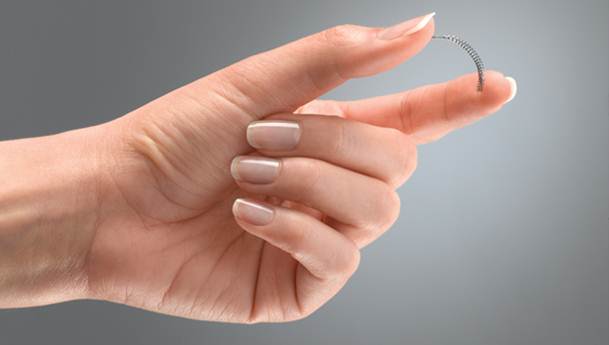There are new and improved ways to end your
risk of falling pregnant, writes Joanna Hall
When the birth control pill was first
introduced in the US back in 1960, it was hailed as a major part of the women’s
liberation movement, offering sexual freedom as well as unprecedented control
over reproduction.
In the 50 years since then, however, many
other effective contraception options have been developed. For those women and
men who are sure they don’t want to have children, or feel their family is
complete, there are several ways to permanently end the risk of falling
pregnant.
For her
Tubal
ligation
This method, often called ‘having your
tubes tied’, involves surgically blocking the fallopian tubes to prevent sperm
from reaching an egg. The most common method in Australia involves putting
clips on the tubes.

Most
women who undergo tubal ligation, or surgical sterilization, do so with the
intention of not having any more children
“It takes about 20 minutes, and is
performed under a general anesthetic using a laparoscopy, or keyhole surgery,”
says Dr Elizabeth Farrell, a consultant gynecologist and founder of the Jean
Hails Foundation.
Several small incisions are made in the
abdomen, and a telescope is inserted to give the surgeon a view of the internal
organs. A clip is then placed on each fallopian tube across its full width.
The recovery time after a tubal ligation is
up to six days. Post-surgery, however, some pain and nausea can be expected for
the first few hours, some abdominal discomfort for 24 to 36 hours from the gas
used to inflate the abdomen, and stitches will need to be removed seven to 10
days later. This procedure is effective immediately, however, and although the
failure rate is only around one in 500 women, there are other reasons why the
surgery isn’t always successful. “Even though the clips are applied correctly,
the tube can sometimes reopen,” says Farrell.
There are also risks such as infections and
ectopic pregnancy, where a pregnancy develops in the tube rather than the
uterus.
“There is also the overall risk of having a
general anesthetic,” says Farrell. “And there are the risks of having
laparoscopic surgery, which can include perforation of blood vessels or nearby
organs such as the bowel or the bladder.”
In the 1990s, 19.2 per cent of women aged
18 to 49 had permanent protection from pregnancy because of tubal ligation. By
2001, however, just nine per cent of women used sterilization as a method of
contraception.
According to Farrell, tubal ligation is
less popular largely because of other available contraceptive options. “It is
also only for women who are certain they don’t want children in the future,”
she says.
“Reversal is possible, but it’s not just
about removing the clips. The piece of the tube which had the clips on has to
be removed, and the tubes reattached again using microsurgery, which is a
complex procedure,” Farrell warns.
New
& improved
A newer and less invasive method of female
sterilization is Essure. It takes around 15 minutes to perform and requires a
micro-device – a tiny coil of titanium – placed inside each fallopian tube.
This causes excess tissue to grow around the inserts, blocking the tubes.
Although the procedure is usually carried
out under a general anaesthetic, the fallopian tubes are accessed through the
vagina, offering benefits over tubal ligation.

Essure
is a proven permanent birth control procedure that works with your body to
create a natural barrier against pregnancy
“The primary one is that it is painless and
doesn’t involve incisions,” says Dr Judith Fleming, a consultant gynaecologist
from Melbourne. “If you have the procedure on a Monday morning, you’d be
comfortably back on your feet by Tuesday afternoon.”
Post-procedure symptoms can include cramps,
a light discharge, and nausea from the anaesthetic, while risks include
infection, bleeding, damage to blood vessels, nerves or muscles, and possible
damage to the bladder, uterus or bowel.
The procedure is not effective immediately.
“You will need to have an X-ray or ultrasound after three months to make sure
the tubes are fully blocked,” says Fleming. “Until then, you will need to use
contraception.” It is irreversible, with a low failure rate of around two per
cent.
For him
Vasectomy
This is the only permanent option for men,
a surgical procedure which involves closing off the vas deferens, the
sperm-carrying tubes, to prevent sperm from becoming part of the semen.
Performed under a general or local anaesthetic, a small incision is made in the
front of the scrotum, and through it each vas deferens is either cut, tied or
blocked, and sealed off.
Although it is a quick and simple
procedure, taking just 15 minutes, post-surgery there may be temporary
discomfort such as pain, bruising, bleeding or swelling.

Vasectomy
is the only permanent option for men
“There are no significant advantages or
disadvantages of one method of vasectomy over another,” says Dr Philip
Goldstone, medical director of Marie Stopes International Australia. “It can, however,
take some time for sperm in the vas deferens and the associated glands to be
cleared from the system. So it is recommended that a sperm count is carried out
three months, afterwards, and after 20 ejaculations.”
There are many advantages of vasectomy; it
is more than 99 per cent effective, and has few, if any, long-term
complications. “Some men have mistaken beliefs that a vasectomy may affect
their sex life by reducing their sex drive, or that ejaculation may somehow be
different,” says Goldstone. “Neither is true.” In fact, many men find that
their sex life is improved following a vasectomy, as they no longer have the
worry of an unplanned pregnancy.”
It is also a common form of contraception;
according to Andrology Australia, about one in four men in Australia have the
procedure. Should a man have a change of heart, however, Goldstone says a
successful reversal is more likely in the first few years.
“The success rate declines with increasing
time,” he says. “Even if the surgery is successful in reopening the vas
deferens, semen quality can be reduced.”
As with female sterilization, the decision
to undergo a vasectomy should not be taken lightly. “It is considered a
permanent method of contraception,” says Goldstone.
“Therefore, whatever his age or situation,
any many considering the procedure should be certain he does not wish to have
any, or more, children.”